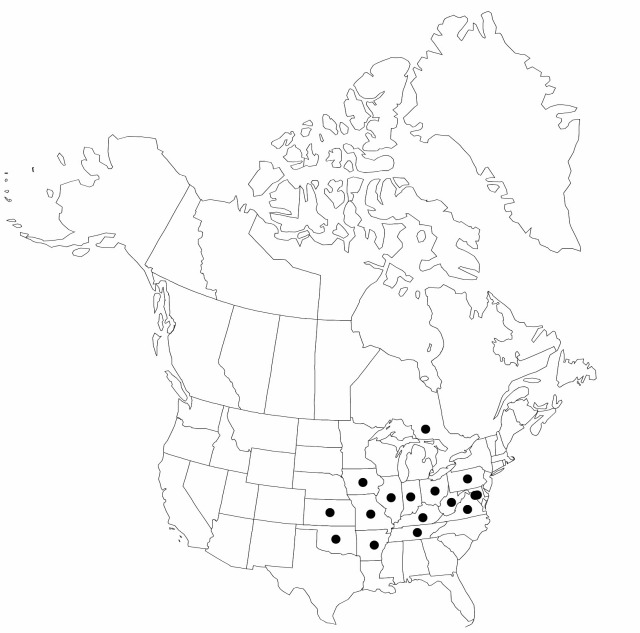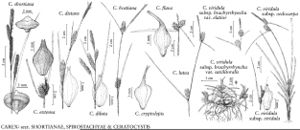Difference between revisions of "Carex shortiana"
Amer. J. Sci. Arts 30: 60, plate Aa, fig. 87. 1836.
FNA>Volume Importer |
FNA>Volume Importer |
(No difference)
| |
Revision as of 21:12, 16 December 2019
Culms in medium- to large-sized clumps, 30–90 cm. Leaves cauline, usually overtopping culms; blades 10–40(–50) cm × 4–9 mm. Inflorescences with proximal spikes ± strongly separate on slender peduncles, others approximate and short-pedunculate or subsessile, narrowly oblong to cylindric, 1–4 cm × 3.5–5.6 mm; lateral spikes, if gynecandrous, with ca. 30–140 pistillate flowers distally and (0–)1–10 staminate flowers proximally; terminal spikes staminate proximally, 1/2–3/4 pistillate distally. Pistillate scales ovate, 1.5–3.2 mm, mostly not quite as long as perigynia. Perigynia olive green to brown, very broadly compressed-obovoid, sharply edged, 2–2.6 × 1.8–2.4 mm; beak often projecting out at 90° angle. Achenes widely oblong-obovoid, 1.5–1.8 × 1–1.3 mm, apex short-apiculate.
Phenology: Fruiting late spring–summer (May–late Jul).
Habitat: Rich woods at bases of slopes, more commonly swampy woods and thickets, wet, open grounds such as spring-fed meadows, prairie swales, pond margins, low depressions, streams, and ditches, particularly characteristic of bottomlands, often in calcareous soils
Elevation: 10–500 m
Distribution

Ont., Ark., D.C., Ill., Ind., Iowa, Kans., Ky., Md., Mo., Ohio, Okla., Pa., Tenn., Va., W.Va.
Discussion
Confined to the interior of eastern North America, Carex shortiana is common west of the Allegheny Mountains, especially throughout the Ohio River Valley. It is notable among tristigmatic carices in having all the spikes gynecandrous, the lateral ones conspicuously repeating the pattern of the terminal spike.
Carex shortiana rarely hybridizes with either C. squarrosa or C. typhina in the Midwest and produces the sterile hybrid C. ×deamii F. J. Hermann. The spikes of the hybrid are subcylindric as in C. shortiana but thicker (7–8 mm instead of 3.5–5.6 mm), and the perigynia resemble those of C. squarrosa but with their bodies more compressed and beaks intermediate in length (1–1.5 mm). Plants of that hybrid are known from Indiana (F. J. Hermann 1938, 1940b), Missouri (J. A. Steyermark 1958, 1963; G. Yatskievych and J. Turner 1990; G. Yatskievych 1999+), Illinois (W. J. Hess and P. Shildneck 1982), and Kentucky (supporting specimens in PH). The second parent has been hypothesized to be C. typhina, but all evidence strongly suggests C. squarrosa (D. K. Evans, unpubl. data), although either may occur at stations from which C. ×deamii is known.
Selected References
None.
